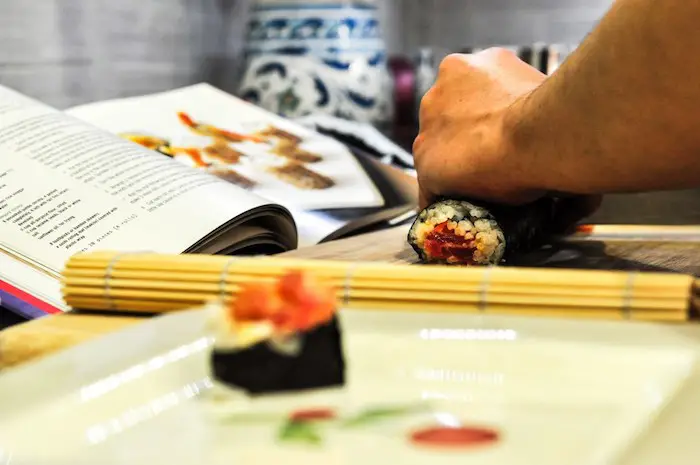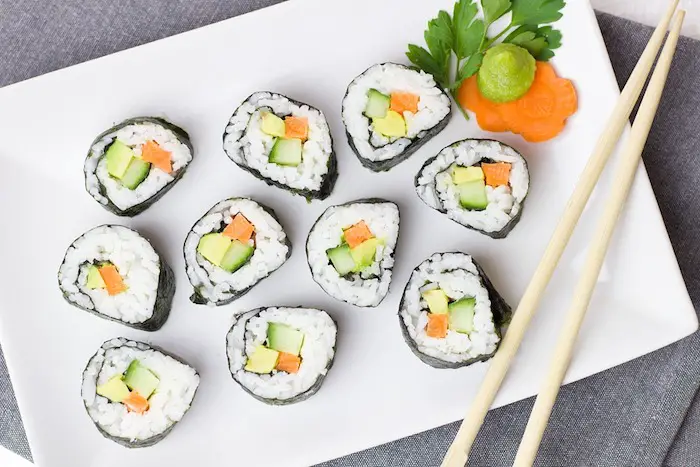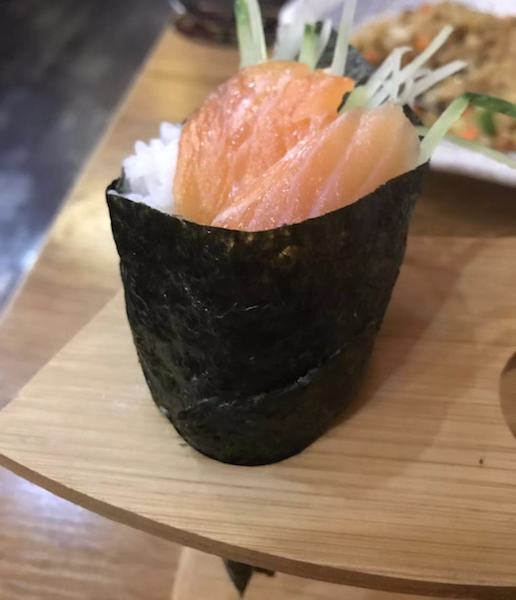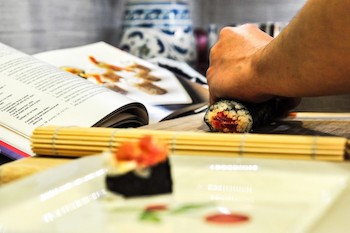We are reader supported. When you purchase through links on our site, we may earn an affiliate commission. Also, as an Amazon affiliate, we earn from qualifying purchases.

Making sushi is no less than an art – a culinary art to be precise. The beautifully seasoned white rice with brightly colored veggies and glistening raw fish rolled into a sheet of Nori evokes a unique visual pleasure. For a newbie, rolling sushi might seem a
Newbie sushi enthusiasts often ask me about the different ways to roll sushi. As a beginner, I would recommend that you practice with the traditional Hosomaki style that involves rolling the bamboo mat horizontally and compressing as you roll. You may also roll seeweed vertically to make the Futomaki sushi, roll it inside out for California roll or roll it cone style.
The rolling technique is extremely important when making sushi because it determines how well the ingredients stay up together. I would recommend that you buy a bamboo mat and have plastic sheets handy to get perfect and neat rolls when making sushi at home.
Contents
Why are there different ways to roll sushi?
Traditionally, a sushi roll is made by placing the seaweed wrap on the top and sushi rice and others fillings inside it. In this style, the first thing the taster feels on the tongue is Nori orseaweed. When Sushi became popular in the western countries, people were not a great fan of Nori and they found the blackish green wrap not so appealing.
As a result, sushi chefs started a different way to roll sushi in order to appeal the westerners. In this method, they rolled the sushi inside out to have Nori inside and sushi rice on the top, garnished with sesame seeds etc.

Another interesting way to roll sushi is to
Wait, that’s not all. I also discovered a really fun way to roll sushi other than the typical horizontal or vertical way- in cone style. I love the way the ingredients pop up like an ice cream topping. Although I feel this style of rolling makes it difficult to eat
#1. Traditional Rolling Technique (Hosomaki)
Yes, I call it traditional because this is the way they roll in Japanese restaurants and how I prefer rolling my sushi at home too. To get it right, you need a Nori seaweed wrap, seasoned sushi rice, peeled and cut veggies, bamboo mat, plastic wrap, and a bowl of water.
Now place the bamboo mat on your kitchen counter and put the plastic sheet on it. Keep the Nori wrap upon the plastic sheet and apply an even layer of sushi rice. You may add some seasoning at the center to enhance the taste.
Now place the cut veggies or thin slices of raw fish in the middle, slightly towards your end. Start rolling in the horizontal direction away from you using the bamboo mat to get a perfect shape. Make sure you get a nice cylindrical or square shape, whatever you desire.
Dip a sharp knife like this in the bowl of water and cut out 6-8 slices of the roll and serve with mayo and soy sauce. Remember to moisten your hands when handling sushi rice to avoid the grains from sticking on your hands.

#2. Rolling Your Sushi Inside Out (Uramaki)
This is another interesting style of rolling sushi inside out so that the Nori is still there but you cannot see it on the top. It not only enhances the visual appeal of the dish but also makes sure Nori is not the first thing that touches the tongue. This type of sushi is called the California roll.
For this style of rolling, you will need vinegared sushi rice, julienne cut veggies, cooked crab meat, sesame seeds for garnish. You may use imitation crab sticks instead of crab meat.
To start making California rolls at home, you need to place the bamboo mat on an even surface on the kitchen counter with a plastic sheet on it. Place the Nori seaweed wrap over the plastic and apply a layer of vinegared sushi rice on the seaweed. Sprinkle some toasted black and white sesame seeds generously on the rice to give it a nice texture.
Next, flip over the Nori sheet to have it facing upwards. This is another advantage of using sticky rice as it does not fall off when flipped over. Put a few pieces of veggies and thin strips of crabmeat on the Nori sheet, in the middle section, slightly towards you.
Now use the bamboo mat to start rolling in the same way as you rolled in the traditional style, away from you. Make a neat cylindrical roll. You may sprinkle some more sesame seeds on the top or use other garnish of your choice. Now take a sharp knife, moisten it and cut the roll into 6-8 equal pieces. Serve with wasabi sauce or any other sauce of your choice.

#3. The Fat Sushi Roll (Futomaki)
If you are the type who craves for varieties of fillings inside the sushi roll, you may try out the Futomaki style. While sushi connoisseurs will tell you to limit your ingredients for fillings to one or two so that you can relish the taste without one overpowering the other, some people just love cramming up their roll with lots of goodies.
To give Futomaki rolling technique a go, remember that the more is better, so get as much good stuff as you can. I would recommend julienne cut cucumber, cut avocados, thin strips of spring onions, and well-cut slices of sushi-grade fish.
Start by placing the bamboo mat with the plastic wrap on an even surface. Now put the Nori wrap vertically on the plastic sheet. Apply a layer of sushi rice as usual and sprinkle some sesame seeds (optional).
Now, place the fillings on your side of the Nori sheet and start rolling the sheet away from you with the help of the bamboo mat. Apply gentle pressure to compress the ingredients to make a thick and fuller sushi roll also known as Futomaki in Japanese.
Make sure you do not press too hard or you may not get an even shape. Wet the ends to seal the seaweed wrap. As this is a shorter and thicker roll, use a sharp knife to cut it out into 4 equal pieces.
#4. Roll into a cone (Temaki)

If you like experimenting with different ways to roll sushi, this is one style worth trying. Do something non-authentic and roll your sushi like an ice-cream cone. It not only looks appealing to the eyes but also makes a delectable treat. However, be careful while eating your sushi cone roll as you might spill the ingredients if you are not careful.
To make your sushi cone, you will need a Nori sheet, seasoned sushi rice, sliced sushi-grade fish, and julienne cut vegetables. You will not need a bamboo mat for this method. Place the Nori sheet on the kitchen counter and apply a layer of sushi rice to one-half of the sheet that is towards you.
Put the raw fish and vegetables diagonally on the section where you have applied sushi rice. Now start from the corner on your side and roll the Nori sheet into a cone shape. Take some sushi rice to work as a glue to close the open end. Serve with your favorite sauce.
How To Roll Your Sushi Without A Bamboo Mat
Have you ever wondered how the sushi rolls come out so well at the restaurants? It’s because they use a bamboo mat. Of course, the good practice has its own advantage and there’s nothing compared to that. However, if you have the right tools at your disposal, rolling sushi at home becomes easier and you may even manage to do it like a pro.
In the above-mentioned ways to roll sushi, I have recommended using a bamboo mat almost every time because it’s an important part of the process. But, what if you don’t have a bamboo mat or it is not available in a store near you? Is there any substitute for a bamboo mat?
Well, you may use your tea towel, also known as the dish towel as an amazing substitute for the bamboo mat. When you use a tea towel as a base for rolling, use the same set-up as you do with a bamboo mat but remember to place the plastic wrap over the towel. If the tea towel is rough, it can rub against the seaweed and make it difficult to roll.
Now hold the tea towel and start rolling the Nori sheet just like you do in the traditional
What Are The Different Sushi Rolling Machines?
If you are new to sushi making, try out some of the sushi rolling machines that take
I personally prefer the Sushi Bazooka Making Kit on Amazon as it has everything you need to make sushi in a traditional way. So, instead of buying a bamboo mat and recipe book separately, you get them all rolled in a kit. It can also cut sushi rolls into perfect sizes.
Another interesting product is the Sushi Making Kit by iSottcom. It works well for both beginners as well as professionals. The best part is that you don’t need to do any rolling for the roll at all! It’s so easy that you can involve kids for a fun sushi party for children. The product is handmade from natural materials and comes with clear instructions on how to use it.
While these sushi roll making machines look great and they can also deliver good results, I personally feel that there’s nothing like rolling in the traditional manner. It might take some time, lots of practice and a little patience, but using just
Related Questions
Why is it important to use plastic wrap when rolling sushi?
The plastic wrap helps in trapping the moisture between the seaweed sheet and sushi rice. This makes the Nori sheet more pliable while rolling. It also helps in keeping your bamboo mat or teatowel clean so that you don’t need to wash them frequently.
How to keep the sticky sushi rice from sticking on your hands
Always moisten your hands before taking sushi rice to create a layer on the Nori sheet. While you may use a spoon for this, I personally believe hands help you get an even layer. You must also wet your knife before cutting slices of sushi rolls to prevent rice from sticking on the knife.
Related Question: How to Make Sushi Rice More Sticky?
How to close the loose ends of sushi roll
The ends will be the trickiest part of rolling so make sure you seal them well to avoid wasting your efforts. You may wet the open ends of the seaweed wrap to seal the roll correctly. Alternatively, you may also use some sticky rice or sauce to close the ends.
Are there any substitutes for seaweed wrap?
If you don’t like the taste of seaweed, you may substitute it with thinly cut cucumber sheets, rice paper, soy wraps, and tofu skin to name a few. You can also have a look my previous article – 7 Ways To Make Sushi Without Seaweed
The Final Words
This traditional Japanese cuisine has evolved a lot from what it used to be in the past. It has undergone various modifications to appeal to westerners and adapt to the tastes of different regions. However, the base ingredients remain the same as before.
No matter how you choose to roll your sushi– the traditional way, inside out, vertically or into a cone, make sure you have a perfect balance of ingredients. It’s the blend of the exotic flavors of crispy seaweed, vinegared rice, soft fish, and veggies that make all the difference!
Make sure you use good quality Nori as this is the first thing that will touch the tongue of the taster, with the exception of California rolls. The sushi rice should be properly seasoned with vinegar, sugar, and salt. Finally, the fillings should be fresh and properly cut into thin slices that make each bite feel heavenly.


Comments
Pingback: How To Make Cucumber Sushi Rolls At Home? - Easy Homemade Sushi
Pingback: How to Make Sushi Rice More Sticky? - Easy Homemade Sushi